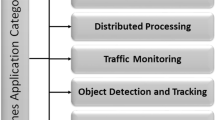Abstract
Vehicular ad hoc networks (VANETs) are a subset of mobile ad hoc networks that provide communication services between nearby vehicles and also between vehicles and roadside infrastructure. These networks improve road safety and accident prevention and provide entertainment for passengers of vehicles. Due to the characteristics of VANET such as self-organization, dynamic nature and fast-moving vehicles, routing in this network is a considerable challenge. Swarm intelligence algorithms (nature-inspired) such as ant colony optimization (ACO) have been proposed for developing routing protocols in VANETs. In this paper, we propose an enhanced framework for ACO protocol based on fuzzy logic for VANETs. To indicate the effectiveness and performance of our proposed protocol, the network simulator NS-2 is used for simulation. The simulation results demonstrate that our proposed protocol achieves high data packet delivery ratio and low end-to-end delay compared to traditional routing algorithms such as ACO and ad hoc on-demand distance vector (AODV).






Similar content being viewed by others
References
Al-Sultan S, Al-Doori MM, Al-Bayatti AH, Zedan H (2014) A comprehensive survey on vehicular Ad Hoc network. J Netw Comput Appl 37:380–392
Mokhtar B, Azab M (2015) Survey on security issues in vehicular ad hoc networks. J Alex Eng. doi:10.1016/j.aej.2015.07.011
Li F, Wang Y (2007) Routing in vehicular ad hoc networks: a survey. J IEEE Veh Technol Mag 2:12–22
Sharef BT, Alsaqour RA, Ismail M (2014) Vehicular communication ad hoc routing protocols: a survey. J Netw Comput Appl 40:363–396
Perkins CE, Bhagwat P (1994) Highly dynamic destination-sequenced distance-vector routing (DSDV) for mobile computers. J ACM SIGCOMM Comput Commun Rev 24:234–244
Clausen T, Hansen G, Christensen L, Behrmann G (2001) The optimized link state routing protocol, evaluation through experiments and simulation. In: Proceedings of the IEEE symposium on wireless personal mobile communications
Santa J, Tsukada M, Ernst T, Mehani O, Gómez-Skarmeta AF (2009) Assessment of VANET multi-hop routing over an experimental platform. Int J Internet Protoc Technol 4:158–172
Perkins CE, Royer EM (1999) Ad hoc on-demand distance vector routing. In: Proceedings of the 2nd IEEE workshop on mobile computing systems and applications, WMCSA’99, pp 90–100
Johnson DB, Maltz DA (1996) Dynamic source routing in ad hoc wireless networks. J Mob Comput 353:153–181
Dong H, Zhao X, Qu L, Chi X, Cui X (2014) Multi-hop routing optimization method based on improved ant algorithm for vehicle to roadside network. J Bionic Eng 11:490–496
Jabbarpour MR, Jalooli A, Shaghaghi E, Noor RM, Rothkrantz L, Khokhar RH, Anuar NB (2014) Ant-based vehicle congestion avoidance system using vehicular networks. J Eng Appl Artif Intell 36:303–319
Souza AB, Celestino J, Xavier FA, Oliveira FD, Patel A, Latifi M (2013) Stable multicast trees based on ant colony optimization for vehicular ad hoc network. In: Proceedings of international conference on information networking (ICOIN'13), pp 101–6
Kayacan E, Ahmadieh Khanesar M (2016) Fuzzy neural networks for real time control applications. Elsevier, Amsterdam
Zadeh LA (1965) Fuzzy sets. J Inf Control 8:338–353
Zadeh LA (2001) Fuzzy logic toolbox for use with MATLAB. The MathWorks, Inc., Natick
Kuchaki Rafsanjani M, Fatemidokht H (2015) FBeeAdHoc: a secure routing protocol for BeeAdHoc based on fuzzy logic in MANETs. Int J Electron Commun (AEÜ) 69:1613–1621
http://en.wikipedia.org/wiki/Bandwidth (computing)
Chatterjee S, Das S (2015) Ant colony optimization based enhanced dynamic source routing algorithm for mobile Ad hoc network. J Inf Sci 295:67–90
Dorigo M, Caro GD (1999) Ant colony optimization: a new meta-heuristic. In: Proceedings of the 1999 congress on evolutionary computation (CEC 99), Washington
Godbole V (2012) Performance analysis of bio-inspired routing protocols based on random waypoint mobility model. J Def S & T Tech Bull Sci Res Technol Inst Def (STRIDE) 5:114–134
Krajzewicz D, Erdmann J, Behrisch M, Bieker L (2012) Recent development and applications of SUMO—simulation of urban mobility. Int J Adv Syst Meas 5:128–138
Acknowledgement
The authors would like to express their thanks to the anonymous referees for their comments and suggestions which improved the paper.
Author information
Authors and Affiliations
Corresponding author
Ethics declarations
Conflict of interest
The authors declare that they have no conflict of interest.
Rights and permissions
About this article
Cite this article
Fatemidokht, H., Kuchaki Rafsanjani, M. F-Ant: an effective routing protocol for ant colony optimization based on fuzzy logic in vehicular ad hoc networks. Neural Comput & Applic 29, 1127–1137 (2018). https://doi.org/10.1007/s00521-016-2631-y
Received:
Accepted:
Published:
Issue Date:
DOI: https://doi.org/10.1007/s00521-016-2631-y




